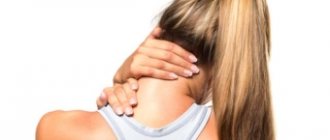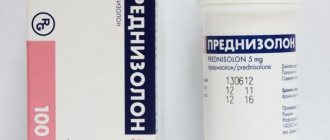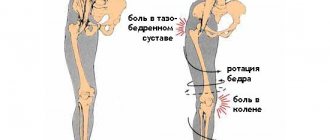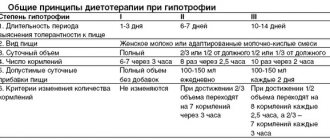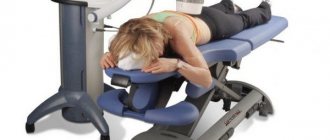Myositis: what is it?
Muscle inflammation develops due to the penetration of infectious agents or the action of other non-infectious factors.
When muscle fibers of the tissue are damaged, painful nodules appear and problem areas become denser. In the acute form, the symptoms are pronounced, the patient experiences discomfort, and the disease interferes with professional activities. Chronic myositis causes no less inconvenience than acute inflammation: constant, aching back pain, muscle tension, the appearance of compactions and knots in elastic tissue, and limited mobility of the spine disrupts the course of life. Problems with performing usual tasks against the background of pain provoke irritability and depression.
The later the patient pays attention to the signs of myositis, the higher the risk of diffuse (extensive) damage to muscle tissue. In the absence of treatment or uncontrolled use of folk remedies instead of taking NSAIDs, antibiotics and muscle relaxants, new tissues are involved in the pathological process, and discomfort increases. The presence of a chronic source of infection worsens well-being and increases the risk of complications when fungal, viral infections, or dangerous parasites spread to other parts of the body.
Causes
Back myositis is characterized by impaired muscle contractility and blood circulation in the affected area. It can occur in acute or chronic form, and occur under the influence of a number of factors. The most common provocateur of back muscle myositis is a previous infectious viral pathology - influenza, tonsillitis or acute respiratory viral infection. Bacterial or fungal infection is somewhat less common. Other reasons include the following:
- back injuries - bruises, sprains, spinal fractures;
- metabolic disorders due to diseases of the musculoskeletal system;
- treatment with drugs from the statin group, as well as Alpha Interferon, Colchicine and Plaquenil;
- excessive physical activity, improper execution of exercises during sports training;
- prolonged stay in a static, uncomfortable position;
- muscle cramps, intercostal neuralgia;
- parasitic infestations;
- hypothermia of the body, especially in combination with high load and overstrain of the spinal muscles;
- autoimmune pathologies – rheumatoid arthritis, scleroderma, systemic lupus erythematosus;
- psycho-emotional overload.
Myositis caused by influenza often resolves on its own, so influenza should be treated first.
There are several types of myositis of the back muscles - infectious (purulent), local, eosinophilic, giant cell and idiopathic. The disease can affect the chest, shoulders, legs, but most often the neck and back are affected. In the latter case, not all muscle structures, but individual groups, are involved in the pathological process. The lumbar region is especially vulnerable, since it bears the main load. When the lumbar muscles become inflamed, the pain often radiates to the lower extremities.
Reasons for development
Inflammation of the back muscles develops when there is an infection in the body or under the influence of other negative factors. Sometimes doctors identify a combination of negative causes, which increases the pain syndrome and the severity of the pathological process. Inflammation is more difficult to treat if the patient has autoimmune diseases: the immune system attacks muscle cells, considering them foreign.
Learn about the symptoms of vertebral artery syndrome in cervical osteochondrosis and the treatment of the disease.
Read about how to choose an orthopedic corset for the spine and for what diseases to use the product on this page.
Myositis develops in the presence of the following diseases and factors:
- improper metabolism;
- injury to the back and spine;
- development of parasitic infection;
- hypothermia;
- monotonous body position throughout the working day;
- influence of toxic substances on the body
- past infectious diseases: chronic tonsillitis, ARVI, influenza, sore throat;
- muscle spasms, convulsions due to neurological and orthopedic diseases.
Myositis code according to ICD – 10 – M60.
Clinical picture
Manifestations of the disease largely depend on the form of myositis: with a chronic course, the development of nodules and dense formations, the signs are blurred, discomfort is easily confused with the symptoms of orthopedic pathologies: osteochondrosis, spondyloarthrosis, spondylosis. With the development of purulent inflammation, the patient is faced with pronounced signs.
Key symptoms of myositis:
- limited mobility of the spine due to excessive muscle tension;
- aching pain in the lumbar region, less often in other areas;
- palpation of muscles, active movements increase discomfort;
- as the pathology progresses, dense areas and nodes appear in the muscle tissue;
- pain persists not only during exercise, but also at rest.
The main symptoms of myositis in an acute process include:
- chills;
- muscle strain;
- temperature increase;
- redness, swelling of tissues in the pathological area;
- at rest the pain intensifies.
Development of a chronic process in the back muscles:
- gradual increase in local pain;
- with palpation and muscle contraction, the pain syndrome intensifies;
- swollen areas gradually lose mobility;
- muscle weakness develops, without proper therapy the tissues atrophy;
- headaches are common, the sensitivity of the skin in the area of chronic inflammation increases;
- Often patients feel general weakness;
- discomfort in the back increases when turning, bending, or while moving.
Diagnostics
If you experience pain in the back or the appearance of signs indicating the development of an acute inflammatory process, you need to consult a rheumatologist. The doctor conducts an examination, palpates the areas of the back where discomfort is felt, and prescribes a series of tests. Diagnosing myositis is not easy: the disease has symptoms similar to the manifestations of orthopedic and neurological pathologies.
To make a diagnosis, the following is prescribed:
- blood test: you will need a general and biochemical research method to clarify the nature and degree of inflammation, select the optimal antibacterial and antiparasitic drugs;
- electromyography. The use of electrical stimulators shows the functional state of problem muscles;
- blood test for antibody levels. The study is carried out to exclude autoimmune pathologies that complicate the course of the inflammatory process;
- examination of the patient on a tomograph (MRI). In cross-sectional images, the doctor can easily identify the affected muscle areas;
- biopsy. Doctors prescribe excision of a small amount of muscle tissue as a last resort: when it is difficult to make a diagnosis. The highly informative method requires surgery to take a sample.
If signs of purulent myositis appear, you should immediately visit a rheumatologist: the acute form quickly becomes chronic, and diagnosing the pathology is much more difficult.
Diagnosis of the disease
When the first symptoms occur, it is recommended to consult a neurologist, therapist and rheumatologist. At the initial stage of the disease, a therapist consults. Only he can prescribe the examination of other doctors. You should contact a therapist at the first pain localized in the legs, back or neck.
Depending on the etiology of the disease, the doctor will advise and give a referral to the right specialist. Autoimmune diseases are treated by a rheumatologist, a therapist’s competence includes the treatment of myositis associated with colds, and a neurologist treats neuromyositis and dermatomyositis.
First, the patient is examined and interviewed. In addition, diagnosis of the disease includes various studies, so the patient must be prepared to undergo tests on a paid basis.
Diagnostics includes:
- conversation with the patient;
- thorough inspection;
- rheumatic tests are carried out in the laboratory;
- instrumental studies;
- taking a biopsy test.
Conversation with the patient
A very important step that should not be neglected. As a result of the survey, factors that led to the development of a disease such as myositis can be identified; it is recommended to identify symptoms and prescribe treatment.
It is the responsibility of the physician to ask the patient the following questions:
- “Which symptoms are most worrisome at the moment?”
- “What was the first symptom?”
- “Is the temperature rising? And if it increases, how often?”
- “Were there any injuries or hypothermia?”
- “Tell me about your existing diseases.”
- “What diseases have you suffered recently?”
- “Name the diseases suffered in childhood.”
- “What diseases is there a genetic predisposition to?”
Carrying out an inspection
After interviewing the patient, the doctor begins the examination. During observation, he pays attention to the skin: he diagnoses paleness of the skin or, conversely, redness.
If redness of the skin is noticeable over the elbow area, nodules or plaques are peeling, the doctor proceeds to examine the patient’s nails. At the initial stage of development of dermatomyositis, redness appears on the nail bed, and skin growth is observed.
You may be interested in: Torticollis in an adult
Next, the doctor performs palpation, since the affected muscle must be felt and the most painful points identified. Assessing muscle tone is also important. The acute period of the disease is characterized by the development of hypertonicity. Skeletal muscle thus exhibits its protective function against irritants: flu, colds, stress. For example, if the neck muscles are in constant tension, this makes it difficult for the patient to walk. Inflammatory processes that have become prolonged can disrupt the swallowing process.
Purulent myositis of the back is detected by palpation, as a result of which painful points are felt. The pain is unbearable.
Laboratory research
To diagnose local or systemic diseases, the doctor prescribes a rheumatic test. As a result of the study, many factors are confirmed or refuted. A rheumatic test is a reliable way to identify the etiology of myositis.
Taking tests for a biopsy
The diagnostic research method involves taking pieces of tissue for the purpose of their subsequent study. As a result of the analysis, changes in the structure of muscle and connective tissue are determined. And also vessels.
A biopsy is prescribed if there is suspicion of:
- myositis of an infectious lesion;
- polymyositis;
- polyfibromyositis;
- dermatomyositis.
The studies carried out help determine the nature of the disease.
Effective treatments
How to treat myositis? Many patients come to see a rheumatologist with advanced cases. When clarifying complaints, causes of pathology and methods of therapy, the doctor learns that the patient used folk remedies, but complex treatment was not carried out. This common mistake often leads to severe cases of illness, atrophy of the back muscles, and partial disability.
When treating myositis, a combination of several areas of therapy gives a positive result:
- Physiotherapy.
- Taking NSAIDs, muscle relaxants and analgesics.
- Diet.
- Massotherapy.
- Physiotherapy.
- Taking antibacterial and antiparasitic compounds.
- In case of acute inflammation, bed rest must be observed.
- Use folk remedies after consultation with a rheumatologist.
- The use of systemic and local drugs to affect the affected muscles from the outside and inside.
- Reducing the negative effects of autoimmune pathologies.
- A combination of work and rest, avoiding overload, avoiding heavy lifting and intense training.
Warning! In case of acute pain or inflammation, the affected area should not be heated. The best option is to apply cold for two to three days at intervals of 2–3 hours (duration no more than 15–20 minutes). Thermal procedures are allowed after the acute process has stopped, otherwise the infection spreads through the blood and lymph flow to other parts. You should not heat the problem area if the nature of acute myositis is non-infectious: under the influence of heat, inflammation intensifies.
Effective drugs:
- NSAIDs. Ibuprofen, Ibusan, Nurofen, Voltaren, Febrofid, Finalgel. It is important to combine external remedies with taking capsules, syrups, and tablets.
- Analgesics. Baralgin, Tempalgin, Solpadeine, Indomethacin.
- Antibiotics if a bacterial infection is detected.
- Immunosuppressants if the patient has severe autoimmune diseases.
- Muscle relaxants to relax spasmodic muscles. Sirdalud, Tolperil, Baclofen, Tolperisone, Mydocalm.
- B vitamins.
Effective physiotherapy:
- diadynamic currents;
- phonophoresis;
- UHF heating;
- electrophoresis with the drug Hydrocortisone.
Other types of procedures:
- acupuncture relieves muscle pain, relaxes tense tissues, and stimulates lymph flow;
- hirudotherapy improves blood circulation in the affected areas;
- After eliminating acute inflammation, a complex of exercise therapy has a positive effect. Initially, classes are conducted by an experienced physiotherapist or rehabilitation specialist. In the future, the patient performs therapeutic exercises at home;
- Therapeutic massage reduces muscle spasms, activates blood circulation, and strengthens muscles.
Folk remedies for treating myositis at home:
- poultices with infusion of chamomile and elderberry flowers;
- ointment made from lard and chopped sage;
- treatment of painful areas with a mixture of vegetable and essential oils: rosemary, fir, pine;
- compress of steamed burdock leaves;
- homemade ointment made from butter and horsetail;
- a compress of cabbage leaves, on which a mixture of soda and soap foam is applied;
- applying lard or lard to painful areas.
Learn about the reasons for the development of grade 1 kyphoscoliosis in the thoracic region and about options for correcting the curvature.
This article explains what physiological lordosis of the cervical spine is and how to correct the deformity.
On the page https://vse-o-spine.com/bolezni/simptomy/lyumbago-s-ishiasom.html read about what lumbago with sciatica is and how to treat a negative symptom complex.
Treatment of back muscle myositis
Treatment of the described disease is conservative. It is based on general and local purposes.
Common uses are:
- non-steroidal anti-inflammatory drugs (NSAIDs) - usually tablet forms are sufficient, and injectable anti-inflammatory drugs are prescribed only if the tablet form has no effect. These are ibuprofen, indomethacin, naproxen or more modern drugs, but with virtually the same active ingredients;
- B vitamins.
The following are used as local treatments:
- warming semi-alcohol compresses;
- gels and ointments made on the basis of NSAIDs;
- physiotherapeutic methods – UHF, microwave.
Prevention measures
Eliminating the inflammatory process in the back muscles is a long process that requires an integrated approach. Doctors recommend familiarizing yourself with the rules for preventing myositis.
Seven useful tips:
- During the working day, change your body position more often, do a warm-up, and prevent muscle strain.
- Avoid drafts, dress well when working outdoors in the autumn-spring period.
- Timely and completely treat infectious pathologies, fight parasites in the body.
- If a patient is diagnosed with autoimmune diseases, as prescribed by a doctor, take medications that suppress the negative effects of immune cells on organs and tissues.
- Prevent exposure to toxic substances.
- When engaging in hazardous sports, wear protective equipment.
- Avoid improper lifting of loads, jerking, sudden bending and turning.
It is important to know the symptoms of myositis in order to contact a rheumatologist in time to prescribe effective therapy. An advanced inflammatory process leads to muscle weakness, discomfort when moving, increased pain regardless of the patient’s actions, and decreased ability to work.
Myositis is a general name for diseases characterized as inflammatory lesions of skeletal muscles of various origins, various symptoms and course. Learn more about the disease from the following video, a fragment of the program “About the Most Important Thing”:
Symptoms of back muscle myositis
The clinical picture of myositis of the back muscles is quite characteristic. Usually these are local symptoms, which in advanced cases may be accompanied by signs of a violation of the general condition.
Local symptoms of the described disease are:
- pain;
- dysfunction of the back muscles.
The characteristics of pain will be as follows:
by location - most often the muscles in the lumbar back are affected, less often - in the thoracic region;
- in terms of distribution - irradiation as such is not typical;
- by nature - the pain is usually aching, although it can be “shooting”, while simulating radicular syndrome;
- by severity - pain can range from mild to severe and even painful;
- by occurrence - appear as the inflammatory process progresses in muscle masses.
Muscle dysfunction means that the patient cannot fully flex or straighten the back.
note
General symptoms usually appear with an infectious lesion and the occurrence of intoxication syndrome in advanced cases.
Common signs are hyperemia (increased body temperature), weakness and malaise, and headaches.

